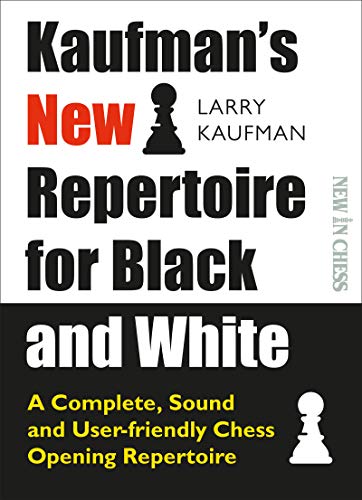Kaufman’s New Repertoire for Black and White
Larry Kaufman

Kaufman’s New Repertoire for Black and White by Grandmaster Larry Kaufman is a first-rate opening repertoire book which frequently recommend lines in which the strategic goal, when possible, is the acquisition of the bishop pair.
This is the third edition of Kaufman’s opening repertoire and the second published by New in Chess. The present work is considerably changed since the previous one although it continues to offer an opening repertoire for both White and Black and not just one color which is standard practice. While the use of computer engines to evaluate opening lines has become the norm today, Kaufmann is particularly noted for his expertise in this field, especially for his work with Komodo. The analysis given in Kaufman’s New Repertoire for Black and White is based on work done with a high-powered computer especially built to the author’s specifications.
The biggest change compared to the previous edition is the author’s return to advocating 1.e4 over 1.d4.
Kaufmann offers both a primary White opening repertoire as well as some interesting and topical sidelines. The main lines are:
1.e4 e5 Ruy Lopez with 6.d3.
Sicilian – 2…Nc6/ 2…d6 3.Bb5+/3.Bb5, 2…e6 3.c3
Caro-Kann – 2.Nc3/3.Nf3
French – 3.Nd2
For Black things are a more complicated. While the Gruenfeld is the proposed answer to 1.d4, no less than three defenses to the Ruy Lopez: the Breyer (9…Nb8), Marshall (8…d5) and Moller (5…Bc5) are offered. The English is met by 1…c5 with 2…Nf6 and 3…d5 and 1…Nf6, 2…g6 and 3…d5. Answers to the London System, Veresov (1.d4 Nf6 2.Nc3 d5 3.Bg5 h6 – two bishops please!), 1.b3, 1.b4 and 1.f4 are also given.
Kaufmann organizes his material around model games with the vast majority from the past decade. There are many notes but they tend to be of a theoretical nature. While there is some explanatory prose this is definitely a book for players 2200 and above and those who aspire to become masters. This is not surprising as while the author packs a lot of material into this book, he is also covering a lot of ground – books this length on just a single opening are not uncommon. The openings that are advocated, especially with Black against the Ruy Lopez, are those used by World Championship level players and not often seen at the club level.
